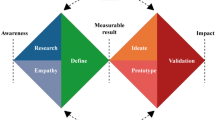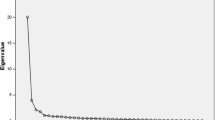Abstract
Computer education in secondary schools aims to equip students with a creative problem solving ability (CPSA) and to enhance information literacy needed in the information age. One of the most popular instructional tools for computer education is to use textbooks. Therefore, it is necessary to develop a quantitative analysis model of CPSA in computer textbooks by analyzing the exploration procedure, the problem solving process, and the content analysis in textbooks, focusing on CPSA. Therefore, the goal of this paper is to propose a technique to analyze how much CPSA is presented in computer textbooks. Finally, the validity of the proposed analysis techniques in CPSA are verified by conducting construct and content validity, a confirmatory factor analysis, and a path analysis. The experiments were verified by 153 experts, who have teaching experiences of computer education in secondary schools. The data was analyzed using SPSS 18.0 and Amos 20.0 software tools.


Similar content being viewed by others
References
Bloom, B.S.: Taxonomy of Educational Objectives-Book1: Cognitive Domain. Longman, New York (1956)
Bransford, J.D., Stein, B.S.: The IDEAL Problem Solver. Freeman, San Francisco, CA (1984)
Camargo, C.A.S., Cavalheiro, G.G.H.: Aproximating static list schedules in dynamic multithreaded applications. Cloud Comput. 17(2), 155–168 (2014)
Charles, R., Lester, F.K.: Problem Solving: What, Why & How. Dale Seymour Pub, Palo Alto, CA (1980)
Cho, M.: An Analysis on the Inquiry Activities for Self-directed Learning: Focused on the ’Social Studies’ Textbook of Tenth Grade, the Degree of Master of Education. Graduate School of Education Sungshin Women’s University, Seoul, Korea (2008)
Dale, N., Lewis, J.: Computer Science Illuminated, 3rd edn, pp 17–23. Jones and Bartlett Publishers (2007)
Dale, N., Lewise, J.: Computer Science Illuminated. Jones and Bartlett Publisher, Sudbury, MA (2007)
Deek, F.P., Turoff, M., McHugh, J.A.: A common model for problem solving and program development. IEEE Trans. Edu. 42(4), 331–336 (1999)
Dewey, J.: How We Think. Free Press, New York (1910)
Gronlund, N.E.: Stating Behavioral Objectives for Classroom Instruction. Acmillan, New York (1978)
Jo, E.: An Analysis on the Question Types of Inquiry Activity in Social Studies Textbook: In Case of Tenth-Grade. The degree of Master of Education, Graduate School of Inha University, Incheon, Korea (2008)
Kim, J.H., Kim, Kim, S.H., Kwon, H.S., Jun, D.Y., Kim, S.J., Kim, H.C., Lee, W.G.: Computer education curriculum and instruction: specification of objectives and contents in “problem-solving methods and procedures” section of the informatics curriculum. J. Korea Assoc. Comput. Edu. 11(1), 33–46 (2008)
Kim, J.H., Kim, H.G., Kim, H.S., Kim, H.C., Lee, W.G.: Cognitive components definition of creative problem-solving ability in informatics education. J. Korea Assoc. Comput. Edu. 11(2), 1–12 (2008)
Kim, D.: Amos A to Z. Hakhyunsa, Seoul (2009)
Kim, Y.D., Choi, G.S., Lee, J.Y.: Analysis of creative problem solving Literacy in problem-solving methods and procedures parts presented in informatics textbooks in middle schools. J. Korea Assoc. Comput. Edu. 15(1), 1–11 (2012)
Lee, S.J., Chang, Y.K., Lee, H.N., Park, K.Y.: A study on the development of life-skills: communication, problem solving and self-directed learning. Korean Educational Development Institute, RR 2003–15-3 (2003)
Lee, J.H.: A Comparative Study of Korean and American Elementary Mathematics Curricula from a Cognitive Viewpoint -with focus on 2nd and 3rd grades multiplication case studies-. The degree of Doctor of Education, Graduate School of Ewha Womans University, Seoul, Korea (2003)
Lencher, G.: Creative Problem Solving in School Mathematics, pp. 19–45. Houston Mifflim Co., Boston, MA (1983)
March, H.W., Balla, J.R., McDonald, R.P.: Goodness of fit indices in confirmatory factor analysis: the effect of sample size. Psychol. Bull. 103(3), 391–410 (1988)
Morris, R., Felix, W., Dieter, K., Achim, S.: Research advances by using interoperable e-science infrastructures. Cloud Comput. 12(4), 357–372 (2009)
National Council of Teachers of Mathematics (NCTM): Arithmetic Teacher Series (1984, 1985)
Nicely Jr, R.F.: Higher-order thinking skills in mathematics textbooks. Edu. Leadersh. 42(7), 26–30 (1985)
Park, S.Y.: Contents Construction Method for Informatics Textbook Based on Developmental Characteristics of Elementary School Students. The degree of Master of Education, Graduate School of Korea National University of Education, Chungbuk, Korea (2008)
Polya, G.: How to Solve it, 5th edn. Princeton University Press, Princeton, NJ (1948)
Romey, W.D.: Inquiry Techniques for Teaching Science. Prentice-Hall, Englewood Cliffs, NJ (1968)
Schoenfeld, A.H.: Mathematical Problem Solving. Academic Press, Inc, London (1985)
The Nevada Legislature: Nevada Computer and Technology Education Standards (2000)
Tucker, A., Deek, F., Jones, J., McCowan, D., Stephenso, C., Verno, A.: A Model Curriculum for K-12 Computer Science: Final Report of the ACM K-12 Task Force Curriculum Committee, CSTA (2003)
Vemo, A., Carter, D., Cutler, R., Hutton, M., Pitt, L.: A Model Curriculum for K-12 Computer Science Level 2 Objectives and Outlines. SIGCSE05, St. Louis, Missouri, USA (2005)
Welch, M.: The problem solving strategies of young designers. ERIC Document Reproduction Service NO., pp. 401–491 (1996)
Wing, J.M.: Computational thinking. Viewp. Commun. ACM 49(3), 33–35 (2006)
Xiong, Lei, Tan, Qingping: A dynamic approach to tolerate soft errors. Clust. Comput. 16(3), 359–366 (2013)
Yoon, I.K., Kim, J.H., Lee, W.G.: Operational definition of components of logical thinking in problem-solving process on informatics subject. J. Korea Assoc. Comput. Edu. 13(2), 1–14 (2010)
Acknowledgments
This work was supported by the research grant of Chungbuk National University, Republic of Korea in 2013.
Author information
Authors and Affiliations
Corresponding author
Rights and permissions
About this article
Cite this article
Choi, G.S., Lee, J.Y. & Yoon, H.S. Development of a quantitative analysis model of creative problem solving ability in computer textbooks. Cluster Comput 18, 733–745 (2015). https://doi.org/10.1007/s10586-015-0433-0
Received:
Revised:
Accepted:
Published:
Issue Date:
DOI: https://doi.org/10.1007/s10586-015-0433-0




